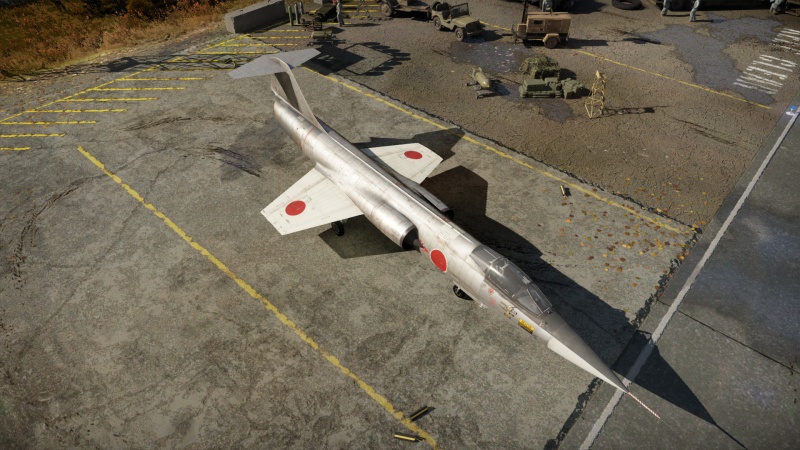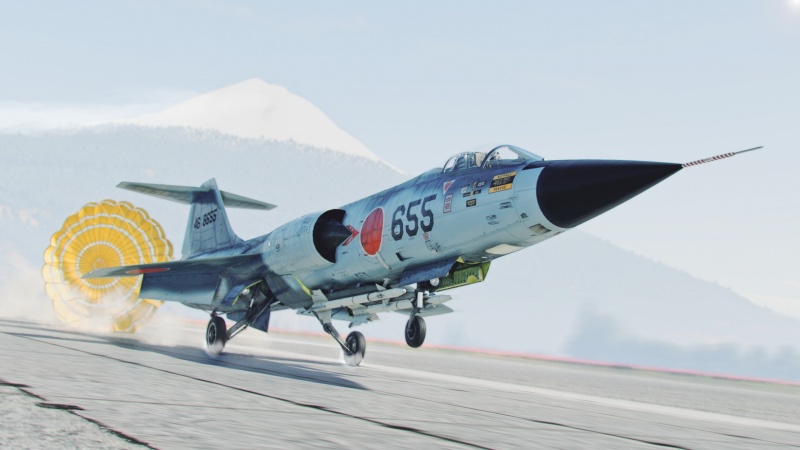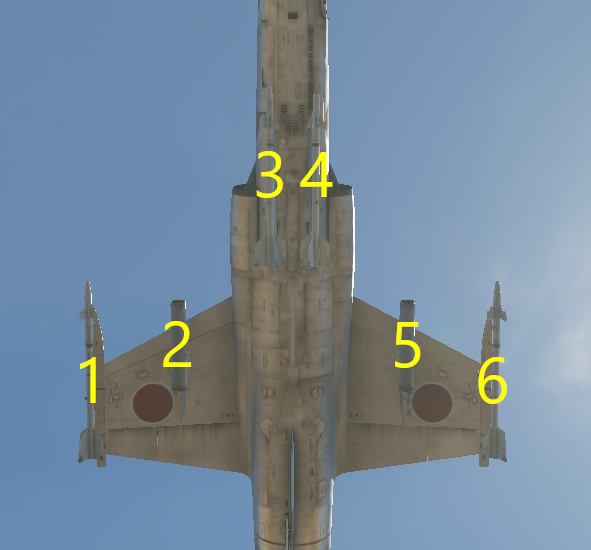F-104J
| This page is about the Japanese jet fighter F-104J. For other versions, see F-104 (Family). |
Contents
Description
The F-104J Starfighter, nicknamed 栄光 (Eiko, lit. Glory) or 三菱鉛筆 (Mitsubishi Pencil) by JASDF pilots, was the imported and license-produced F-104G solely for the JASDF as the winner of the F-X program, which sought for new interceptors against Soviet bomber fleets. The F-X project originally opted for a Japanese version of the F-100 from North American Aviation, but this was cancelled due to the lack of need for a fighter-bomber. Later in 1959, after evaluations on supersonic performance of available jets of the era, the JASDF eventually opted to introduce the F-104G but removing ground-attacking equipment from the Starfighter, which in turn became what's known as the F-104J and was produced by Mitsubishi Heavy Industries (MHI) domestically. As future jets like the F-4EJ and F-15J joined the JASDF between 1970s to 1980s, as well as the infamous reliability of Starfighters both domestically and overseas, the JASDF phased out the fleet of F-104Js after 1986. Some of these jets were supplied to the ROCAF under Project Alishan #9 (阿里山9號計劃) after they returned to USA (F-104Js were property of both the USAF and JASDF), while some were modified into UF-104J target drones for combat training.
Introduced in Update "Starfighters", the F-104J was the main interceptor of the JASDF with precise ground-attack capabilities removed. Although being known as a jet with poor manoeuvre capabilities at low speed, with its high top-speed and sufficient missile payload, players can certainly cause major troubles to enemy aircraft and enemy attackers/bombers will need to think twice before entering the combat area.
General info
Flight performance
The F-104J's performance can be summarised in one word: speed. For it to work effectively, you must be fast. Below 1,000 km/h, your elevator will be ineffective for any combat manoeuvres. Though it may be helped by the deployment of combat or takeoff flaps as speed allows, even those will not be able to keep up with the other aircraft it faces at its battle rating. This being said, the aircraft is very responsive overall, especially in the roll aspect.
The short wings must be discussed with some nuance. Though they allow for great roll authority, their effectiveness at low speeds is severely limited. Below 6-800 km/h, you will find that level flight is difficult, if not impossible. Due to this, a very high landing speed is required, which amplifies small mistakes. Even with the perfect pilot, landing this aircraft every time is going to be a challenge.
Finally, the aircraft is only fast in a straight line. When turning, it loses significant speed, often losing any energy advantage it may have had before the turn.
| Characteristics | Max Speed (km/h at 15,240 m) |
Max altitude (metres) |
Turn time (seconds) |
Rate of climb (metres/second) |
Take-off run (metres) | |||
|---|---|---|---|---|---|---|---|---|
| AB | RB | AB | RB | AB | RB | |||
| Stock | 2,343 | 2,317 | 34.5 | 35.1 | 230.5 | 222.5 | 850 | |
| Upgraded | 2,431 | 2,387 | 35.5 | 34.0 | 292.0 | 260.0 | ||
Details
| Features | |||||
|---|---|---|---|---|---|
| Combat flaps | Take-off flaps | Landing flaps | Air brakes | Arrestor gear | Drogue chute |
| X | ✓ | ✓ | ✓ | ✓ | ✓ |
| Limits | ||||||
|---|---|---|---|---|---|---|
| Wings (km/h) | Gear (km/h) | Flaps (km/h) | Max Static G | |||
| Combat | Take-off | Landing | + | - | ||
| 1,527 | N/A | 827 | 444 | ~12 | ~5 | |
| Optimal velocities (km/h) | |||
|---|---|---|---|
| Ailerons | Rudder | Elevators | Radiator |
| < 720 | < 950 | < 800 | N/A |
Engine performance
| Engine | Aircraft mass | ||||||
|---|---|---|---|---|---|---|---|
| Engine name | Number | Basic mass | Wing loading (full fuel) | ||||
| General Electric J79-GE-11 | 1 | 6,552 kg | 532 kg/m2 | ||||
| Engine characteristics | Mass with fuel (no weapons load) | Max Takeoff Weight | |||||
| Weight (each) | Type | 10m fuel | 20m fuel | 30m fuel | 35m fuel | ||
| 1,615 kg | Afterburning axial-flow turbojet | 7,345 kg | 8,057 kg | 8,809 kg | 9,194 kg | 24,000 kg | |
| Maximum engine thrust @ 0 m (RB/SB) | Thrust to weight ratio @ 0 m (WEP) | ||||||
| Condition | 100% | WEP | 10m fuel | 20m fuel | 30m fuel | 35m fuel | MTOW |
| Stationary | 4,128 kgf | 6,357 kgf | 0.87 | 0.79 | 0.72 | 0.69 | 0.26 |
| Optimal | 4,128 kgf (0 km/h) |
8,391 kgf (1,200 km/h) |
1.14 | 1.04 | 0.95 | 0.91 | 0.35 |
Survivability and armour
The aircraft has some survivability, although it should be noted that due to its small size, any hits to the rear of the plane are very likely to cause engine damage, which will be problematic due to the horrible gliding ability of this aircraft. The structure, however, makes it difficult to knock out the pilot from behind. Also, due to the high tail structure, it is easy to destroy the tail entirely, which will result in a near-total loss of control. Though the flaps may be utilized to some extent, at lower speeds, they will falter, making it very hard to take a damaged aircraft back to the runway.
When a wing is fully lost, the aircraft will suffer from an extreme roll that may only be countered by using the rudder and remaining aileron simultaneously. At this point, the aircraft is practically impossible to land and should be considered lost.
The plane also has no armour protection.
Modifications and economy
Armaments
Offensive armament
The F-104J is armed with:
- 1 x 20 mm M61A1 cannon, nose-mounted (750 rpg)
Suspended armament
The F-104J can be outfitted with the following ordnance:
| 1 | 2 | 3 | 4 | 5 | 6 | ||
|---|---|---|---|---|---|---|---|
| Hydra-70 M247 rockets | 7 | 7 | |||||
| FFAR Mighty Mouse rockets | 19 | 19 | |||||
| AIM-9B Sidewinder missiles | 1 | 1 | 1 | 1 | 1 | 1 | |
| AIM-9E Sidewinder missiles | 1 | 1 | 1 | 1 | 1 | 1 | |
| AIM-9P Sidewinder missiles | 1 | 1 | 1 | 1 | 1 | 1 |
| Default weapon presets | |
|---|---|
| |
Usage in battles
The Flying Mitsubishi Enpitsu (Pencil)
One thing F-104J leaves the impression for JASDF and enthusiasts in aviation is its sleek and "pointy" overall appearance, which eventually leads to a well-known nickname, the Mitsubishi Pencil, a staple stationary for Japanese students. Although not having the dark green color of the pencil, the overall appearance and performance do certainly fit the name Pencil.
For players who takes F-104 series as their very first supersonic jet, one thing that has to bear in mind is the flight performance of F-104 series. By the mid-1950s to 1960s, F-104 opted for the design for maximum speed and climb rate to intercept enemy bombers, thus leading to its iconic sleek design with a pair of shock cones on the sides to compensate for the sound barrier; this design also leads to a completely different flight performance to conventional designs i.e. MiG-19/J-6 series or the F-100 series, dogfighting is never the option for F-104J due to the wing design and overall low lift at lower speeds - this was also a problem addressed during the development. To put it in perspective, most jets with conventional design of swept wing have around 300 km/h landing speed, the SOP of Starfighters called for more than 400 km/h for safer approach; although players can deploy their flaps for tighter radius during battles, they will also have to be extra careful on the TAS since the flaps can still be deployed at up to 900 km/h speed, sometimes violent speed increase/drops will lead to fast separation of the flap surfaces if players didn't pay attention to the speed - this is extremely fatal at lower altitude due to sudden changes of aerodynamic structure. When players opted for its intended role - high-altitude interceptor, the aircraft certainly has sufficient, perhaps great climb rate to fly as high as the game allows, but this also means enemy jets with more advanced avionics and missiles can absolutely detect an object flying at the speed of sound at more than 9 km altitude, especially true for those with SARH missiles. Due to the lack of any countermeasures, players have to utilize their aircraft to dodge any oncoming missiles at all cost; head-on with enemy players is not a good idea if players cannot tell the exact made of aircraft.
Having these features addressed well, players can now consider for how to utilize the aircraft well. Speed is the best friend of F-104J, which it has up to M 2.0 top speed to spare at higher altitude; having 6 AIM-9 series do sound good at first glance, but do remember that both 9E and the 9P are rear-aspect missiles which are prone to flares, so finding enemies who have been distracted by the fight is a very good idea to score victories, its role as interceptor and treaty limits also eliminated options for ground attack. At such, depending on the battle rating, F-104J can both be aggressive and passive as follows:
- As the top tier of the game - Thanks to its excellent speed and missile payload, F-104J has fairly less pressure against subsonic jets or earlier supersonic jets; there are few SARH missiles at its tier as well (most notably, MiG-21MF/PF/SMT with R-3R or F-4C), their unreliable radar can somewhat extends the operational airspace for F-104J but be sure to be keep a keen eye on any jet trails at similar altitude; it can very likely be interceptors with such missiles which are hunting for high-flyers as the altitude basically eliminates ground clutter on the radar, thus leading to better tracking on targets. In case such targets have been taken care off or driven to lower altitude, make sure to utilize F-104J's speed to go for boom-and-zoom tactics and take down any high-threat targets for the team's victory; subsonic jets will have very hard time to chase-off a F-104, make sure to extend the distance between enemies and yourself beforehand, then hold altitude for any opportunities to dive-in for attacks. Only use the flaps when necessary to reduce turn radius and be careful on the speed as mentioned, a wrong move can lead to the crash of F-104.
- As the low tier of the game - This will be the nightmare especially for Starfighters without countermeasures, at higher tiers, not only SARH missiles are commonplace, some jets are equipped with Pulse-Doppler radars which can detect targets even at lower altitude; thus rushing into the battlefield can be said as asking for a quick demise from the enemies. In most cases the tactics still apply from lower tiers, but this time players have to hide from enemies' hunting and stay flying as long as possible, in short words: be passive and hunt down careless targets that are chasing teammates -a jet with 6 missiles onboard is still a threat if enemy didn't pay attention to their rear.
Although the flawed aerodynamic hinder the capabilities of F-104J and the lack of any air-to-ground ordnances make it less effective during research, players that have been used to the flight performance and the timing of their appearance can certainly turns this pencil into a deadly bullet, taking down the toughest enemy possible with unexpected weapons.
Radars
The F-104J is equipped with a NASARR search and tracking radar. The radar is mounted in the nose of the aircraft.
| NASARR - Target Detection Radar | |||
|---|---|---|---|
| Maximum Detection Range |
Guaranteed Detection Range |
Max Azimuth Scan Angle |
Max Elevation Scan Angle |
| 37,000 m (theoretical) |
18,000 m | ±45.0° | ±43.0° |
| NASARR - Target Tracking Radar | |||
| Maximum Tracking Range |
Minimum Tracking Range |
Azimuth Tracking Angle |
Elevation Tracking Angle |
| 18,500 m | 150 m | ±10.0° | ±10.0° |
Pros and cons
Pros:
- Good top speed and acceleration
- Great rate of climb
- Powerful M61 cannon with high fire rate, good damage, excellent velocity, and plenty of ammunition
- Good roll rate
- Can carry a total of 6 potent AIM-9P air-to-air missiles
Cons:
- Very poor overall maneuverability and terrible maneuverability at low speeds
- Bleeds off airspeed quickly in sustained turns
- Very limited air-to-ground ordnance options (only a small amount of unguided rockets), and no ballistic computer
- Lack of flare/chaff countermeasures is a major handicap as the IR missiles the F-104J commonly faces are extremely difficult for it to dodge without flares
History
The F-104J was a specialized interceptor version of the F-104G for the JASDF, built under license by Mitsubishi for the air-superiority role; it was armed with a cannon and up to six Sidewinders (evidence shows it only ever carrying 4 in active operation) but had no strike capability. Called Eiko (栄光, Glory) and sometimes nicknamed by pilots as the Mitsubishi Pencil, they served from October 1962 to 1986, losing only 3 airplanes, including a mid-air collision accident. Seven air-superiority squadrons used them: 201, 202, 203, 204, 205, 206, 207. Japanese F-104s faced intrusive Soviet airplanes during this long service.
- Introduction
With Lockheed gaining ties with the JASDF after introducing the T-33 Shooting Star trainer-jet for the Japanese Airforce. Considering Japan didn't massively import airplanes from the US and with an upcoming next generation of jet planes that would replace the Japanese F-86s by F-100s from North American Aviation made it quite a competition for Lockheed to sell their product instead.
In 1957 Japan sent a investigation team to the USA to wage their options and viable planes for the task at hand. With the increase of Soviet bombers and their potential threat towards Japan and its airspace, the qualifications of the planes being set at:
Speed ≥ Mach 2 Climb rate ≥ 15,500 m within 8 minutes Ceiling ≥ 18,000 m Combat range ≥ 380 km
4 American jets could meet the requirement, and these were: NAA F-100, Convair F-102, Northrop F-5 and Lockheed F-104. At the time, only the F-100 was proven and in use by the US Air Force, the F-5 was still being designed, the F-104 just made its maiden test flight, and the F-102 was the most expensive. Out of this, it seemed like the easiest and best option would be working with North American Aviation as they already had close ties with Mitsubishi considering they licensed their previous era of jets being the F-86 and announced the proposal of the F-100J, an all-weather interceptor variant with nose-mounted radar especially for the JASDF.
On the 13th of September of the same year, the investigation team returned to Japan and submitted their report, but conclusions weren't specified and postponed. It was rumoured that the F-100J would have a short-run production until a full conclusion was made on which jet Japan's next generation of the air-defence jet would be. Still, this plan was fully taken off the table by the then prime minister, Nobusuke Kishi, which dubbed the F-100J as a "Fighter-Bomber" that Japan's defensive nation didn't need.
In January 1958, the chief of the JASDF, Sadamu Sanagi, had conducted a selection from going to America and submitted a report after returning home. In the report, the candidate aircraft were narrowed down to F-104 and G-98J (planned variant of the F11F-1 Super Tiger). Accidents with the F-104 just deployed to the US Air Force. The fact that the aircraft required a 3,000-metre runway and insufficient data link capacity made the option clear for the Defense Agency and decided to adopt the G-98J-11 in 1958.
However, a fair share of criticism for adopting a vehicle that hadn't been proven yet and was still in its development stage made the Agency re-evaluate their choice and eventually withdraw it after a quote of another Chief of staff of the JASDF, Minoru Genda, saying 「乗ってみなければわからない」. He was flown to America to test this new variant of the G-98 and concluded that the G-98 is a Mach 1 class aircraft that was forcibly raised to a Mach 2 class, it might have great subsonic performance and acceleration, but this was neglected once it actually broke the sound barrier due to the swept-wing design.
On the contrary, the F-104 had a straight wing design creating higher drag at subsonic speeds and better supersonic acceleration and manoeuvrability, making the difference in performance between the two very clear. After all the negotiating and carefully considering the options, they decided that it would be better to choose the F-104. It filled the role of Interceptor at Mach 2 better than the G-98 and placed an order of 180 Fighters and 20 Trainers.
- Operational history
The M-2 bombing computer was removed from the F-104J in response to Japan's demand for a sole interceptor, and it was armed with a JM61 Vulcan cannon and AIM-9B/E/P Sidewinder air-to-air missiles. The Vulcan cannon was not initially planned to be equipped, and 180 contracted aircraft have been manufactured unequipped. Later, a Vulcan gun was installed, but of the 210 F-104Js in total, only around 160 were equipped. The muzzle of the unequipped aircraft was blocked, and there was a spare fuel tank in the empty space instead.
Twenty-two Japanese F-104s were eventually converted to UF-104J radio-controlled target drones and destroyed for aerial target practice.
- Retirement
A total of 210 F-104J air-superiority fighters and 20 dual-control trainer F-104DJs were built, three by Lockheed, 29 by Mitsubishi from Lockheed-sourced components, and 178 by Mitsubishi. After being retired and replaced by F-15Js in Japan, the US sold 31 F-104J and 5 F-104DJ aircraft to the ROCAF to replace the remaining fleet of F-104A; due to the incompatibility of spare parts from standard F-104Gs, these obsolete airframes were soon phased out by newer jets in 1991, likely by the CKD version of F-5E produced by AIDC.
Media
- Skins
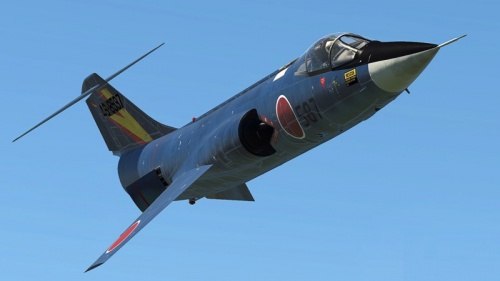
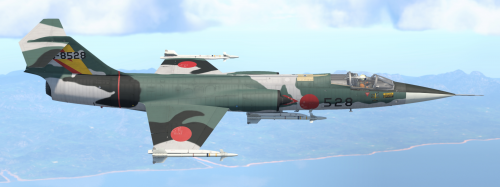
- Videos
See also
Links to the articles on the War Thunder Wiki that you think will be useful for the reader, for example:
- reference to the series of the aircraft;
- links to approximate analogues of other nations and research trees.
External links
| Japan jet aircraft | |
|---|---|
| IJNAS | |
| Experimental | Kikka |
| Reconnaissance | R2Y2 Kai V1 · R2Y2 Kai V2 · R2Y2 Kai V3 |
| IJAAS | |
| Fighters | Ki-200 |
| JASDF | |
| Fighters | F-86F-30 ▅ · F-86F-40 ▅ · F-86F-40 JASDF▅ |
| F-104J | |
| F-4EJ Phantom II · F-4EJ ADTW · F-4EJ Kai Phantom II | |
| F-15J · F-15J(M) | |
| F-16AJ | |
| F-1 | |
| Trainers | T-2 Early · T-2 |
| Foreign | |
| Thailand | ▄AV-8S · ▄F-5E FCU |



